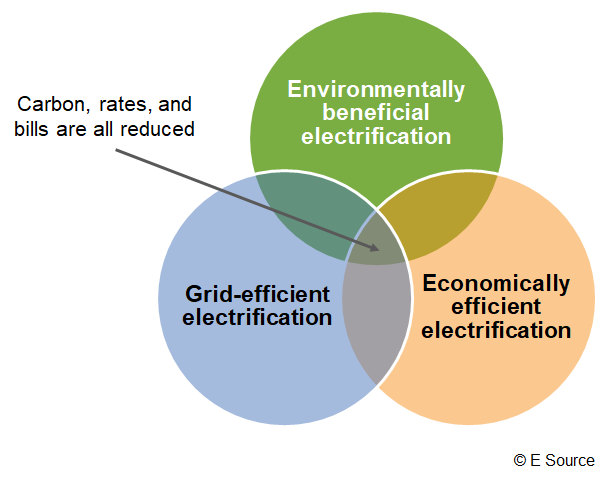
If done correctly, electrification can reduce carbon, lower rates and costs for consumers, and make the grid run more efficiently. But our industry doesn’t even have a common definition of the term “beneficial electrification,” despite our use of it everywhere. Who’s benefiting from electrification? Are there cross-subsidies? If there are winners, aren’t there losers as well? Is the main driver environmental? And if so, how must we change our frameworks for assessing programs?
The good news is that our experience with demand-side management (DSM) gives us a head start on knowing how to structure electrification analysis, as well as how to deliver electrification programs to customers. E Source has created a framework, highlighted in our white paper The Electrification Framework That Benefits Customers, the Grid, and the Planet, that shows how utilities, regulators, and other government entities can more systematically make decisions around electrification. You can apply this approach to building electrification (heating, water heating, etc.) and transportation electrification, as well as some customized commercial and industrial scenarios.
How do you know when and how electrification is beneficial?
We use a three-part assessment framework for testing whether an electrification approach is “beneficial” or not. The three elements are:
- Environmentally beneficial electrification
- Economically efficient electrification
- Grid-efficient electrification
The first test is whether the change improves the environment compared to the former nonelectrified approach, with the focus primarily on carbon output. The second test focuses on whether the change lowers the cost for the consumer—and society—to produce the energy end-use product. For example, if a driver can now go 10,000 miles for $2,000 in an electric vehicle (EV) instead of $5,000 in their gasoline car, that savings is an economic benefit of electrification. The third test determines whether the change improves the efficiency of the grid, putting downward pressure on rates, even for those who don’t directly participate in electrification. Where these three benefits coincide is the sweet spot for new utility approaches (figure 1).
Figure 1: Three-part assessment framework for beneficial electrification
Within this framework, there are numerous inputs that you must consider, such as predicted savings for a new efficient technology, the life-cycle costs, the carbon output of an evolving generation mix for years to come, and the cost of avoided carbon. Policy decisions must come into play as well, including whether:
- Utilities are the right entities to implement these programs (we think they’re well suited)
- We can shift from an avoided-cost framework to one that focuses on net societal and economic benefits
- Jobs are created and displaced
- Vulnerable populations are gaining benefits from these changes
Should there be regulatory incentives for beneficial electrification?
The icing on the electrification cake, so to speak, is incentive regulation. Believe it or not, utilities actually wanted and needed regulatory incentives to help push them toward DSM programs over the years. The reasoning goes, if utilities are going to spend time and effort not building power plants and infrastructure (where they traditionally made their profits), then they should be rewarded for doing so. John Rowe, former chairman of Exelon and New England Electric System, was famously quoted as saying “The rat must smell the cheese.” Not only did bonus incentives proliferate in many states, many jurisdictions decoupled sales from revenue to keep utilities from being penalized for reducing load. Now, decoupling could be a hindrance to electrification. Why should a utility sell more power when it won’t get more revenue or profit?
With beneficial electrification, utilities can profit from building a network that enables lower emissions, lower costs, and even lower rates for customers.
It’s time to take this issue head-on with beneficial electrification, and provide a framework for utilities to profit from building a network that enables lower emissions, lower costs, and even lower rates for customers. These regulatory incentives could reward and compensate utilities for any, or all, of the following elements:
- Recovering program and marketing costs
- Driving rates lower through electrification programs (grid efficiency)
- Creating net efficiency gains—reducing overall Btus for the same “work,” and economic efficiency
- Accelerating the adoption of new technologies (for example, EVs and heat pumps)
- Meeting specific environmental goals and outcomes
These incentives can include sliding-scale bonuses for exceeding goals, essentially becoming performance-based incentives. Our prediction is that electrification will take off when all of these pieces are in place. Whether that will happen sooner, later, or not at all is yet to be seen, but hopefully our electrification framework will make this a smoother transition to the fourth wave of electrification.
What’s the fourth wave of electrification?
We’re in what we consider the fourth wave of electrification, with each wave being incredibly influential on our culture, economy, comfort, and health. The lighting wave, in the first days of utilities in the first part of the 1900s, brought new, clean, and safe lighting and cooking to households and businesses.
We have an opportunity to make the fourth wave the most beneficial, but we need to move quickly.
The second wave rolled in during the mid-1900s, when everyone wanted convenient in-home appliances. Washing machines, TVs, refrigerators, air-conditioners, and all kinds of kitchen gadgets proliferated. And industries automated their operations, bringing tremendous benefits to households and businesses.
Next came the digital wave, starting with computers and then expanding to entertainment, smartphones, the web, Wi-Fi, iPads, and every other computing-based product in our lives. The digital wave shows no signs of ebbing.
Now we’re entering the critical fourth wave of electrification, where we’re primarily focusing on reducing the environmental harm we created with the first three waves. And we’re facilitating a massive historical shift in the transportation sector away from fossil fuels toward clean electricity. We have an opportunity to make the fourth wave the most beneficial, but we need to move quickly to get our decisions framed in the right manner to help all of us, while enhancing the ability for companies to remain viable and profitable.
